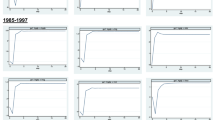Abstract
Since 2002, RMB has shown a phenomenon which is the co-existence of the external appreciation and the domestic inflation. This new monetary phenomenon has been strengthened in the context that US dollar depreciates internationally and that domestic economy is overwhelmed with excessive liquidities. The new monetary phenomenon is the reflection of the real economy that continuing trade surplus, triggered robustly by the export-driven economy, which brings a huge amount of foreign exchange reserve and accelerates sequentially the expansion of domestic money supply. Furthermore, a refrained appreciation of RMB tends to deteriorate the domestic inflation, which is not simply a traditional concept of CPI but a broad inflation parameter including a variety of asset prices. It is sure that the new phenomenon is becoming a new challenge to the macroeconomic equilibrium as well as the decision maker of monetary policy.
摘要
2002 年以来, 人民币出现了对外升值和对内贬值并存的现象。 在国际美元贬值和国内流动性过剩的背景下, 这一货币现象得到了强化。 这一货币现象是实际经济运行的反映: 中国的出口导向型经济强势增长, 国际收支持续顺差带来巨额外汇储备, 进而推动国内货币供应量的扩张。 当汇率和资本流动都受到맜制时, 压抑的对外升值趋势会成为对内贬值的直接原因。 而对内贬值的概念已不是传统意义上的CPI 上涨, 而是包括资产价格膨胀在内的广义通货膨胀。 这对于宏观经济平衡和货币政策制定者来说, 都是一场新的挑战。
Similar content being viewed by others
References
Alchian A A, Klein B(1973). On a correct measure of inflation. Journal of Money, Credit, and Banking, 5(1): 173–191
Bei Duoguang(1988). Macrofinance. Shanghai: SDX Joint Publishing House (in Chinese)
Bei Duoguang(2004). Flow of funds and development of capital market. Economic Research Journal, (10): 84–93 (in Chinese)
Bernanke B S, Gertler M(2000). Should central banks respond to movements in asset prices? American Economic Review, (5)
Bryan M, Cecchetti S(1993). The consumer price index as a measure of inflation. Economic Review of the Federal Reserve Bank of Cleveland, 29(4): 15–24
Bryan M, Cecchetti S, O’sullivan R(2002). Asset prices in the measurement of inflation. NBER Working Paper, No. 8700
CICC Research Report(2005). China Macro Economic Review and Prospect(2005–2007), Oct. 31 (in Chinese)
CICC Research Report(2007). Stock Market Attracts Bank Deposits, Feb. 16 (in Chinese)
Economic Growth Frontier Subject Team(2005). High growth of investment, macro cost and the sustainability of economic growth. Economic Research Journal, (10): 12–23 (in Chinese)
Economic Growth Frontier Subject Team(2005). International capital flows, economic distortions and macro economic stability. Economic Research Journal, (4): 4–16 (in Chinese)
Fang Xianming, Zhang Yihao(2006). Chinese money maze: Evolution and experience evidence. Economic Theory and Business Management, (9): 37–43 (in Chinese)
Friedman B(2000). Monetary policy. NBER Working Paper
Goldman Sachs Global Economics Group(2006). The World and The BRICS Dream
Goodhart C(1999). Time, inflation and asset prices. Paper presented at conference on “The Measurement of Inflation” organized by the Office of National Statistics and Eurostat at the University of Wales, Cardiff, Aug. 30
Greenspan A(1999). New challenges for monetary policy. Opening remarks at a Symposium, Fed of Kansas city
Mckinnon R, Schnabl G(2004). A return to exchange rate stability in East Asia mitigating conflicted virtue. International Finance (2): 169–201
Micheal F B, Stephen G C, O’sullivan R(2002). Asset price in the measurement of inflation. NBER, Working Paper No. 8700
Robert A M(1971). Monetary Theory, Interest, Inflation and Growth in the World Economy. Pacific Palisades, California: Goodyear Publishing Co.
Shibuya H(1992). Dynamic equilibrium price index: Asset price and inflation. Bank of Japan Monetary and Economic Studies, 10(1): 95–109
Xie Ping(2000). The challenge to China monetary policy in the new century. Financial Research Journal, (1) (in Chinese)
Zhang Junwei(2006). The monetary and exchange rate policy game analysis with considering demand shocks. Financial Research Journal, (8) (in Chinese)
Author information
Authors and Affiliations
Corresponding author
Additional information
__________
Translated from Jingji yanjiu 经济研究 (Economic Research Journal), 2007, (9): 32–48
About this article
Cite this article
Bei, D., Zhu, X. A new monetary phenomenon: An analysis of the co-existence of the external appreciation and the domestic inflation of RMB. Front. Econ. China 3, 327–355 (2008). https://doi.org/10.1007/s11459-008-0016-6
Published:
Issue Date:
DOI: https://doi.org/10.1007/s11459-008-0016-6




